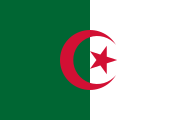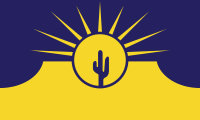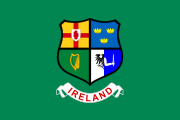User:Intervex/Flags
The purpose of this page is to make an equivalent of Commons:Coats of arms but for flags.
Whether a flag is eligible for copyright protection depends on the country it was made in, and whether it was made by (or for) an official government. While some governments release their intellectual creations as public domain, this is not universally the case. Flags should not be assumed to be public domain just because they are flags.
Starting questions
[edit]To determine the copyright status of a flag, you will generally want to answer:
- Was this flag created or commissioned by a government?
- If so: what level of government? Intellectual property created by/for federal governments often follow different rules than IP created for municipal governments.
- Which country's copyright laws apply to this flag?
- Generally, the answer will be the country in which the flag was made.
- Note: Tribal governments are generally subject to the copyright law of the country that the tribal government considered to be situated within. So, a tribal government operating within US borders is subject to US copyright law; a First Nation operating within Canadian borders is subject to Canadian copyright law, etc.
- Who designed this flag?
- Are they still the copyright holder? If they designed the flag as work for hire, or sold the rights, they may not be the copyright holder
- When was this flag designed?
- Does this fall above or below Threshold of Originality for the country whose copyright laws apply to this flag?
Governmental flags
[edit]While many countries release their national flags as public domain, this is not universal, and should not be assumed. Furthermore, different levels of government tend to be subject to different policies about governmental intellectual property: municipal flags tend to be subject to different laws and policies than federal/national flags. It should not be assumed that a flag is public domain just because it is the official flag of a government.
Federal, national, state, provincial, and territorial governments
[edit]Some governments, like the United States and Mexico, do not claim copyright over their official federal and state flags. (This does not apply to municipal nor tribal flags.)
But this is not universal. For example, in Canada, official flags made or commissioned by federal/provincial governments would fall under Crown copyright and enter the public domain after 50 years[1].
Other countries where artistic government intellectual property (IP) is copyrighted by default include:
- Australia: 50 years (Crown copyright)
- Canada: 50 years (Crown copyright)
- Italy: 20 years
- Malta: 70 years
- New Zealand (Crown copyright)
- Singapore: 70 years
- United Kingdom (Crown copyright)
See Commons:Government works for information on a country-by-country basis.
Municipal governments
[edit]Note that flags created or commissioned by municipal governments do not necessarily follow the same rules as state, provincial, national, or federal governments.
While the US government does not claim copyright on federal and state flags, this does not apply to municipal nor tribal governments. Famously, the 2001 flag of Pocatello, Idaho was successfully copyrighted: see w:Flag of Pocatello, Idaho. Note that Pocatello was able to copyright their 2001 flag because it was above Threshold of Originality in the United States. Flags with simple geometric designs are considered ineligible for copyright in the US. As such, whether a municipal flag is copyrighted is generally a question of how old the flag is, and whether its design is above or below Threshold of Originality (see: Commons:Threshold_of_originality#Flags).
In Canada, municipalities are not eligible for Crown copyright, and municipal flags are treated like flags made by private organizations/individuals[1]. If a municipal flag is too young to be public domain based on age, the next question tends to be whether it is above or below Threshold of Originality in Canada. While Canadian law is roughly aligned with the US in terms of Threshold of Originality, it is not exactly the same. TODO: useful example to differentiate.
Tribal Governments
[edit]Official flags created by Indigenous governments can also be copyrighted. However, whether their flag is considered copyrightable will be depend on the copyright law of the colonial country that they are now situated within.
For example, Ahousaht First Nation located in what is now Canada, holds copyright over their flag per Canadian copyright law. Their flag is visually complex, meaning it is above Threshold of Originality. It was made in 2006, and so is too recent to be public domain. Many First Nations in Canada created their flags as a result of a land claims agreement which formally established the Indigenous government. A very large number of these land claims agreements were made after 1975, due to a combination of changes in policy and important judicial cases[2]. As a result, a large fraction of Indigenous flags in Canada are too young to be public domain on the basis of age.
Many tribal governments in the United States have flags which are copyrighted. While copyright registration is voluntary in the US, many tribal governments have registered their flags and/or seals with the US Copyright office. Many tribal flags in the USA feature the tribe's official seal in the middle of their flag, and so if the seal is copyrighted, the flag is copyrightable as well.
Some of the tribal governments with registered copyrighted flags/seals include:
- Georgia Tribe of Eastern Cherokee
- Lac Courte Oreilles Band of Lake Superior Chippewa Indians
- Lumbee Tribe of North Carolina
- Natchitoches Tribe of Louisiana
- Nez Percé Tribe
- Pamunkey Tribe
- Peoria Tribe
- Rosebud Sioux
- Sault Ste Marie Tribe of Chippewa Indians of Michigan
- Shawnee Tribe
- White Mountain Apache Tribe
Flags by private individuals or organizations
[edit]Flags which are created by non-governmental entities (e.g. private individuals, advocacy organizations, corporations) can be thought of as logos in terms of copyright. Whether such flags are copyright eligible will thus follow the standards for Threshold of Originality of the country it was made in. A clear example of a widely-adopted flag that is too visually complex to be understood as "simple geometry" is The Survivors' Flag by the National Centre for Truth and Reconciliation (Canada).
A famous example of a copyrighted flag is the Australian Aboriginal flag created in Australia by Harold Thomas in 1971[3] Australia's copyright law uses the "sweat of the brow" doctrine: even though the flag is comprised of simple geometry, an Australian court determined that sufficient labour and skill was put into the design for it to be copyrightable. The Australian government acquired the copyright to the flag in 2022, allowing for free usage (see w:Australian_Aboriginal_flag#Copyright).
Threshold of Originality
[edit]Main article: Commons:Threshold of originality
The threshold of originality is a concept in copyright law that is used to assess whether or not a particular work, or a portion of it, can be copyrighted. It is used to distinguish works that are sufficiently original to warrant copyright protection from those that are not. In this context, "originality" refers to "coming from someone as the originator/author" (insofar as it somehow reflects the author's personality), rather than "never having occurred or existed before" (which would amount to the protection of something new, as in patent protection).
Examples of municipal flags which have been deleted from Commons as copyright violations include:
- USA: The city of Pocatello, Idaho successfully copyrighted their 2001 flag; see w:Flag of Pocatello, Idaho.
- USA: Chapmanville, West Virginia holds copyright over their flag, and was deleted from Commons as a result.
- USA: Seattle, Washington holds copyright over their flag and was also deleted from Commons.
- Canada: Although it has a fairly simple design, the flag of Calgary, Alberta is considered copyrighted and was deleted from Commons twice. The stylized stetson hat is considered copyrightable.
- Slovenia: numerous municipal flags from Slovenia have been deleted from Commons as they are copyrighted.
Examples of official flags of tribal governments which have been deleted from Commons include:
- The Rosebud Sioux Tribe. Their flag is a registered copyright in the USA and was speedily deleted from Commons. The stylized teepees are above Threshold of Originality in the USA.
- The Peoria Tribe. Their emblem is a registered copyright in the USA. Their flag features this emblem, and so was speedily deleted. Drawings of feathers are above Threshold of Originality in the USA.
- The Shawnee Nation. Their flag is registered copyright in the USA and was also speedily deleted from Commons. The oak leaves are above Threshold of Originality in the USA.
- The Lumbee Tribe. Their seal is registered copyright in the USA, also resulting in a speedy deletion. Their flag features the seal, and was also speedily deleted. The pattern of overlapping triangles around the edge of the medicine wheel appears to be why this is above Threshold of Originality in the USA.
Examples of official flags which Commons discussions have deemed ineligible for copyright protection include:
-
The Sri Lankan flag was kept after being nominated for deletion, as the lion design was not new and everything else was basic shapes.
-
The Algerian flag was kept on basis of Threshold of Originality (TOO).
-
The flag of Mesa, Arizona was kept on basis of TOO.
-
The personal flag of Queen Elizabeth II was kept as the blazon is not copyrighted. For more on coats of arms see Commons:Coats of arms.
Examples of flags deleted from Commons as copyright violations include:
- The ASEAN flag was deleted for being copyrighted. It had been uploaded as "simple geometry" but determined to be copyrightable in Indonesia.
- This 2005 Coptic Flag was deleted from Commons for being copyrighted. Its centre element is visually complex.
- The "Mexican Deseret" flag on the second page of this linked forum thread was deleted from Commons as a copyright violation. The eagle design is too complex to be "simple geometry".
- This Proposed Svalbard Flag was deleted; its artwork is also considered complex.
- The Cascadian Flag was deleted for being copyrighted: the tree design is considered complex.
- The Hezbollah flag was deleted on the grounds it is too complex and thus copyrightable.
- This Flag of Popular Mobilization Forces was deleted for being copyrighted.
-
The Australian Aboriginal Flag, created by a private Australian citizen, was deleted from Commons because of how it was copyrighted at the time. (A similar design in the United States would likely not have been eligible for copyright protection, for being simple geometry.)
-
This lesbian flag, previously nominated for deletion, was determined to be too simple for copyright protection (USA jurisdiction).
-
The Free Speech Flag was kept as copyright ineligible (USA jurisdiction).
-
This unofficial Palmyra Atoll flag was deemed simple geometry (USA jurisdiction).
-
The Tino Rangatiratanga Maori sovereignty movement flag was kept on the basis of basic geometry (New Zealand jurisdiction).
-
The Ryukyu independence flag was kept on the grounds it is simple geometry (Japanese jurisdiction).
-
This Irish hockey team flag, previously nominated for deletion, was kept on the grounds it had "no real copyrightable creativity". All of the elements in the flag are public domain (Irish jurisdiction).
-
This Irish cricket flag was kept on the grounds the shamrock cannot be copyrighted (Irish jurisdiction).
SVG and Copyright
[edit]TODO fill in
License Tags for Flags
[edit]TODO:
- Edicts are not flags!
- When to use PD-flag
- ↑ a b Copyright at UBC: Public Domain. 2023. University of British Columbia. https://copyright.ubc.ca/public-domain/ Accessed 2024-11-17.
- ↑ A History of Treaty-Making in Canada. Government of Canada. https://www.rcaanc-cirnac.gc.ca/eng/1314977704533/1544620451420
- ↑ A tale of two flags: who owns the right to use? 2019. World Trademark Review. https://www.lexology.com/library/detail.aspx?g=d20ee995-9c08-4805-8f5a-398c3b72121d Accessed 2024-11-17.











